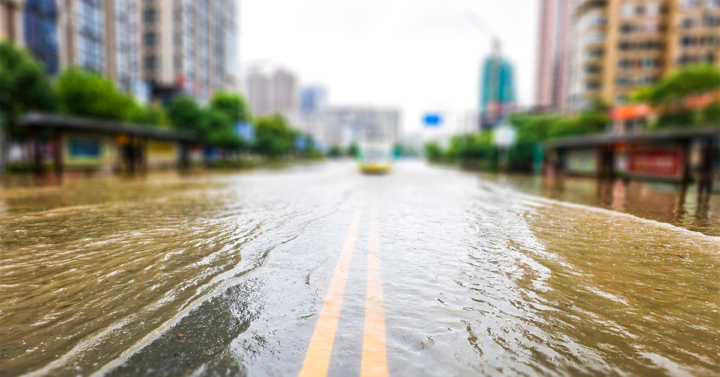
By Frank Grossman, FCIA
You may have heard the old saying, “It never rains but it pours,” suggesting that one’s ills tend to compound themselves. This can literally happen when hot summer weather interacts with the infrastructure of our largest cities. Rainstorms have the potential to be transformed into even stronger storms due to past decisions about urban design, materials, and construction.
A ninja storm comes to town
During the evening of August 7, 2018, after several days of humidity and temperatures that hit 34 degrees Celsius, a summer storm dropped 72 millimetres of rain over Toronto, with 51 mm falling in a single hour. This sudden rainfall caused flooding in the western and central parts of the city, resulting in insured losses of more than $80 million. Filthy, bacteria-laden sewage – toxic waste by another name – flowed in the streets and into the subway system. Total uninsured damages due to overland flooding can only be surmised. As the city’s wastewater-treatment plants were overwhelmed, stormwater overflows scoured the rivers that transect Toronto and eventually delivered their fetid brew to Lake Ontario.
Admittedly, this extreme weather event was dwarfed by torrential downpours that struck Zhengzhou and New York City during the summer of 2021. Both had hourly downpour rates several times greater than the Toronto storm. The prospect of a warmer climate augurs as much. We may expect more localized and intense rainfalls, with significant consequences for urban communities and their infrastructure.
Yet the Toronto storm was unique in several respects. There was no observed lightning, so Environment Canada didn’t issue a thunderstorm warning. Similarly, as the progress of the slow moving and localized disturbance seemed to stall, a city-wide storm alert was not released. The Toronto Star called it a “ninja storm,” noting that “It hovers, then strikes. A relentless rain that floods one part of the city but spares another, then disappears as suddenly as it arrives.” Though the city has dozens of official rain gauges, when storms slip past the gauges their precipitation is not measured and, consequently, not recorded. A local meteorologist speculated that some locations in the urban core received as much as 200 mm of rain during the August 2018 storm.
The brown-ocean effect
Tropical cyclones are basically heat engines that routinely weaken after making landfall. This is fundamentally due to the loss of the ocean heat as their energy source. In recent years, however, a new category of inland tropical cyclones has been identified. Tropical cyclone maintenance and intensification events (TCMI) take their energy from warm wet soils rather than warm seas. It’s been suggested that the heat exchange from land surfaces may even rival that from the ocean, albeit for short periods of time. This means that under certain conditions, storms can intensify after making landfall.
According to Dr. Marshall Shepherd, the “brown ocean” environments associated with TCMI have three defining features. First, the atmosphere’s lower level is tropically warm and humid, with minimal temperature variation. Second, there must be sufficient soil moisture in the vicinity of the storm. Lastly, the evaporation of soil moisture must release enough latent heat over a wide area to mimic the energy released by the ocean. Hence, the brown-ocean effect refers to the ability of saturated soils and wetlands to deliver enough heat energy to maintain, and potentially intensify, a warm-core tropical cyclone.
Cities and climate change
The geography of large cities includes “heat islands” that amplify the risks of climate change. Ambient heat is typically generated by motor vehicles, and the heating and cooling of buildings, but it is also absorbed from the sun by our environment. As a result, hot summer weather is more deadly for city dwellers prone to heat-related illnesses than their similarly afflicted country cousins due to the urban heat-island effect. The 1995 Chicago heat wave, as well as the 2003 European heat wave’s effect on the inhabitants of Paris, are notable examples.
The interaction of urban infrastructure and weather creates other risks too. Consider the ecology of parking lots. Though widely thought to be necessary for urban life, they plainly exacerbate the problem of stormwater runoff by adding to the impervious surface area of a city. But a matter of no lesser environmental consequence is that their countless hectares of concrete and asphalt are an anvil for the summer sun to beat down on – creating a massive urban heat sink. And when the rains come during a heat wave, the threat is not only flooding but also the widespread and rapid evaporation of moisture, and an attendant heat exchange akin to the brown-ocean effect.
What can be done?
There are several adaptive measures that can help to reduce the damage caused by heavy urban rainstorms. Nearly a quarter of Toronto has combined sewers, a single conduit to carry both human waste and stormwater. Instituting a stormwater charge based on the size of paved surfaces or rooftop areas can give property owners a financial incentive to keep run-off on their property – rooftop gardens and buffering rainfall-storage tanks are possible solutions – and out of the sewers. Stormwater-fee revenues could be dedicated to improve water-treatment facilities and the replacement of combined sewers.
In addition, less reliance on concrete, asphalt, and masonry, and less urban sprawl, can help keep cities cooler. Making room for more porous surfaces, such as parkland swales, can also mitigate run-off. Another key adaptation is increasing the urban tree canopy to provide more shade, cool the air through evapotranspiration, and help moderate water flow.
One of the basic challenges of adapting to climate change is the uncertainty of regional rainfall patterns in the years to come. As Lord Stern, a British economist, noted in his 2006 landmark review, “Changes in rainfall patterns and extreme weather events will lead to more severe impacts on people than that caused by warming alone.” Our present risk is that governments will choose to sink billions of dollars into disaster relief and recovery rather than investing in greener infrastructure. After all, it’s much better – and invariably cheaper in the long run – to prepare than to repair.
The actuarial angle
Another challenge is the rear-view-mirror outlook of many actuaries. Is it only the rare actuarial scientist who – faintly echoing Archimedes – has implored others: “Just give me the data and I’ll build a model with it”? In the age of climate change, however, the relevance of historical data generally, and our ability to rely on historical averages in particular, will doubtless be less than in days past. New approaches to data collection will be needed, as illustrated by the failure of Toronto’s rain gauges to accurately record basic information.
The inter-related and combined influences of climate and cities – temperature, moisture, infrastructure, and ultimately people – on urban extreme weather events needs to be better understood. This is especially so as many cities adapt too slowly to keep pace with our changing climate. The August 2018 storm and its disastrous result prompted a veteran Toronto city councillor to remark, “We are sitting in a city that was built for a climate that no longer exists.”
(Note to reader: An earlier version of this article appeared in the SOA Research Institute’s Catastrophe & Climate Research Program Newsletter.)
This article reflects the opinion of the author and does not represent an official statement of the CIA.





